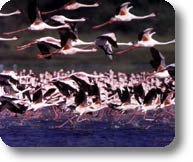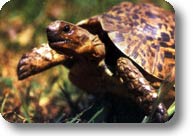







|
Initially established as a bird sanctuary, the Park's careful management and reintroduction program has since ensured a thriving mammal fauna which includes some of Kenya's most rare species. Rare Rothschild's giraffe and endangered black and white rhino are common in the park, amidst large herds of Cape buffalo ranging through the woodlands and grasslands. The acacia woodlands shelter herds of graceful impala, shaggy waterbuck and shy bushbuck; rocky hillsides provide a perfect habitat for rock hyrax. To the south of the lake, herds of Thomson's and Grant's gazelle dot the plains.
Carnivores are well represented by lion, leopard, cheetah, spotted and striped hyena, serval cat as well as the silver-backed and side-striped jackal, civet, genet and mongoose. The most visible primates are the sombre olive baboon and the mischievous black-faced vervet monkey, while dignified troops of colobus monkeys often prance among the trees.
As Kenya's first established rhino sanctuary, the Park hosts one of the largest black rhino concentrations in the country. Two species thrive here: the square-lipped or 'white' rhino, preferring to graze on the short grass of the plains, and its more nervous browsing cousin, the black rhino, that tends to keep to the cover of thicker bush.
Birds
Over 500 bird species have been recorded in the Lake Nakuru area. Most striking, numerous and colorful of the avian residents are the flamingo. Two species occur: the massed pink ranks of the lesser flamingo - at times numbering up to 1.5 million! – and the greater flamingo who visit in smaller numbers. Living alongside them are flamboyant pelicans - the great white pelican and the pink-backed pelican - as well as colorful waterfront birds: duck, geese, heron, stilt, sandpiper and plover.
Birds of prey also abound at Lake Nakuru. The African fish eagle, whose haunting scream and precision swoop shatter the calm of the lake, is striking. Other members of the avian cast include the flouncing ostrich, iridescent sunbird, gleaming starling, swooping bee-eater, chattering weaver and the jaunty oxpecker that ride the necks and backs of larger mammals. |
| Aquatic insects such as midges, primitive crane flies and water boatmen thrive in the lake. A stunning diversity og beetles, butterflies, ants, bees and termites, all playing their essential roles in maintaining a healthy balanced ecosystem by recycling nutrients and providing food for other creatures, are plentiful too. |
| The cliffs and crevasses, reeds and rocks of the Park suits snakes, lizards, chamaleons, and tortoises. They include the legendary African rock python which is capable of swallowing an impala whole, plus the aptly named leopard tortoise and the sky-blue and coral headed Agama lizard, often seen basking and bobbing in the sunshine. |

